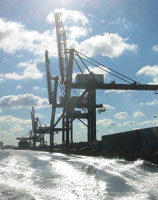 |
| COLOSSAL Bigger cranes and ships require dredging and redesign of port facilities. |
"There have never been this many things changing at once," says Larry Nye, vice president of port planning for Moffatt & Nichol, Long Beach, Calif. Todays planners face an "unprecedented" combination of economic, environmental, security and technological challenges, he says.
Asian countries generate more than 53% of container traffic to the U.S., and "the West Coast is not going to be able to handle all this business," says Nye. Congestion surrounding the two U.S. giantsLos Angeles and Long Beachplus a two-week longshoremens strike in 2002 have pushed major shippers to look for alternatives. As Long Beach caps work on a $585-million new terminal, other ports are pumping up construction to attract and handle shipper business.
The competition is fierce. The demand side of the economy is dominated by a few large retail importers, and "theyre interested in those ports that will give them what they want," says John Rickliefs, port economic director for Moffatt & Nichol.
|
Costs associated with port construction have increased because of security, environmental mitigation and com-munity resistance. "Ports are looking for alternative means of financing," says Phil Crannell, senior vice president for CH2M Hill Cos. Ltd., Denver.
Land constraints are also an issue. "Its increasingly difficult to build larger container terminals for a lot of reasons," says Steve Sewell, vice president for ports with Parsons Brinckerhoff, New York City. "The challenge [is] to make better use of existing infrastructure rather than continuing to build new infrastructure."
At the Port of Charleston, obtaining land for expansion has been a struggle, with 1.7 million 20-ft-equivalent container units (TEUs) a year and growing. "Were in discussions with additional lines and services...that have been delayed somewhat due to capacity," says Port Director Bernard Groseclose. A proposal to site a new terminal on a dredge disposal island met with such opposition that the port redirected plans toward 250 acres on an old navy base. "It is probably one-quarter the size of what could have been at Daniel Island," says Groseclose.
 |
| CONGESTION Construction at busy ports typically must co-exist with nonstop container-loading operations in constrained spaces. (Photo top and below courtesy of the Port of Tacoma) |
To make the most of what it has in Charleston, the South Carolina State Ports Authority has built and is expanding a new Yard Management System at its main terminal with $748,000 in new equipment. Radio frequency relays data in real-time to track truck and container movements in the terminal, reducing trucker check-ins by 40%.
Even ports with room to build face the same goal of more efficiency. "Ports recognize the need to expedite turnaround times at the gates," says Julian Johanson-Brown, port planner for Halcrows New York City office. "This is done through a combination of gate layout design and technology." Designers must understand every aspect of a container yard operation to ensure efficiency.
Optical character recognition, biometrics, electronic tracking of cargo and other technologies "change the configuration required to accommodate automation a bit," notes Ed Schmeltz, senior vice president with DMJM+Harris, Los Angeles.
Where there is room, new container construction abounds. At the Port of Tacoma, a $341-million capital program is going strong, "with 6,000 tons of asphalt going...
onstruction cranes work side by side with ship cranes these days at U.S. ports, where containerized cargo traffic is expected to increase by 350% in the next 20 years. With limited funds, designers and builders of port facilities are trying to move countless shipping containers through the ports and onto the nations highway and rail networks as quickly and safely as possible. Its a difficult task.
Post a comment to this article
Report Abusive Comment